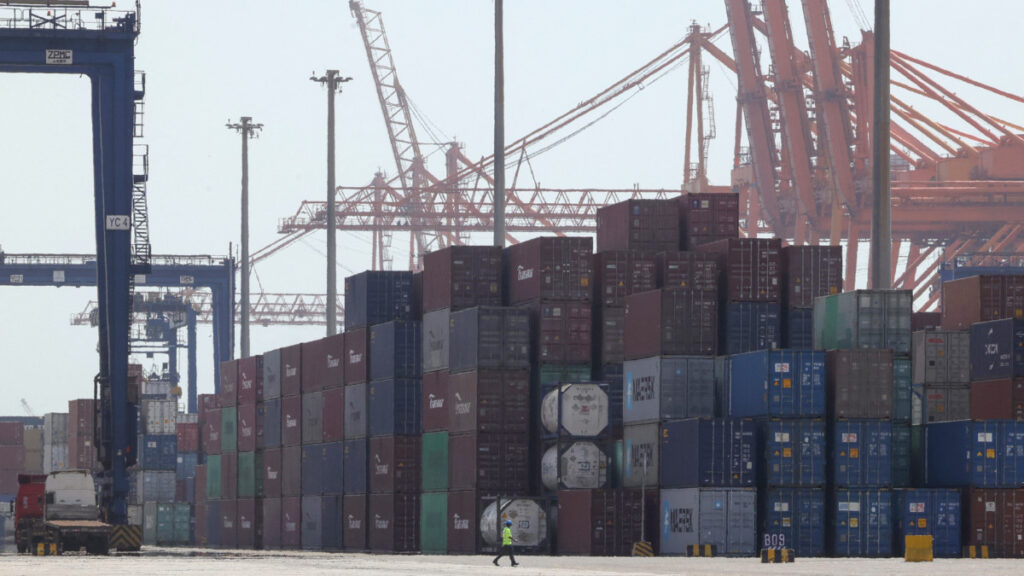Saudi Arabia has bet billions of dollars on the Red Sea ports as part of its bid to diversify its economy away from relying on energy, but the Houthis’ maritime attacks have dealt a blow to those ambitions.
Container ship traffic at Saudi Arabia’s King Abdullah Port dropped nearly 70 percent from 188 ship calls in 2023 to 59 in 2024, according to data shared with Middle East Eye by Marine Traffic, a ship tracking and maritime analytics provider. This year has seen just a slight uptick with 51 container ships arriving to date.
When King Abdullah Port opened in 2014, it had two purposes.
The kingdom believed the port was well-placed on Red Sea trade routes to profit off transshipment, where goods are unloaded from big vessels and reloaded onto smaller ones for their final journey.
Saudi Arabia also wants the port to serve as the entry and exit point for its King Abdullah Economic City, where it is trying to entice foreign companies to open up factories.
New MEE newsletter: Jerusalem Dispatch
Sign up to get the latest insights and analysis on
Israel-Palestine, alongside Turkey Unpacked and other MEE newsletters
The huge drop in traffic mostly reflects a drop in transshipment business, as international shipping companies avoid the Red Sea in response to the Houthis’ attacks, two port executives in the region told Middle East Eye.
“Business at King Abdullah Port is so bad the owners couldn’t sell the container terminal if they wanted to,” one port executive in the region told MEE.
The port is owned by a company linked to the Emirati property developer Emaar and Huta Marine Works. The kingdom’s Public Investment Fund (PIF) in 2021 purchased a 25 percent stake in Emaar The Economic City.
‘The Red Sea is the most important dimension of the Vision 2030 plan’
– Robert Mogielnicki, Arab Gulf States Institute
Saudi Arabia’s Jeddah Islamic Port also saw a drop in traffic, which the two port executives attributed to the Houthi attacks, albeit with much less impact than at King Abdullah Port.
The port saw a 14 percent drop in container ship traffic, down from 400 vessels in 2023 to 344 in 2024, according to Marine Traffic data.
The executives say business has held up better at Jeddah Islamic Port because it is a primary gateway to the western half of the kingdom for imports, as opposed to transshipment.
But executives say that container ships avoiding Saudi Arabia’s Red Sea coast, particularly those arriving from Asia, are making port calls at King Abdul Aziz Port in Dammam on Saudi Arabia’s Eastern coast instead.
“BYD vehicles destined for Saudi Arabia are going to Dammam. Not the Red Sea Ports. It’s safer,” one executive told MEE, referring to the Chinese electric car maker that is capturing market share in the Gulf.
The Houthis began targeting ships in the Red Sea in November 2023, in what they say is solidarity with besieged Palestinians in the Gaza Strip.
Egypt has borne the brunt of the Houthi attacks economically. The Suez Canal is a critical source of foreign exchange revenue for the cash-strapped government in Cairo. Traffic has dried up as vessels plying trade between Asia and Europe reroute around Africa’s Cape of Good Hope to avoid encountering the Houthis.
Saudi Arabia’s Red Sea coast
The rewiring of Saudi Arabia’s port business underscores how the Houthi attacks are having unintended knock-on effects for Riyadh as well.
Crown Prince Mohammed bin Salman’s Vision 2030 aims to reduce the country’s reliance on energy by tapping into tourism and manufacturing. The plan has a geographic component that intends to focus the weight of Saudi Arabia’s non-oil dependent economy on the Red Sea coast, for both luxury hotels and factories.

How BlackRock and an Italian shipping dynasty are upending Middle East’s port business
Read More »
“The Red Sea is the most important dimension of the plan for developing untapped potential – especially non-oil and gas related,” Robert Mogielnicki, a resident scholar at the Arab Gulf States Institute, told MEE.
“In terms of the countrywide transformation, the Red Sea coast is extremely important,” he said.
As far as ports go, Saudi Arabia’s bid to be a new trade stop on the Red Sea faced headwinds from overcapacity.
In recent years, it joined the UAE and Egypt in a port-building boom, hoping to make easy money off transshipment. Executives say there is simply not enough trade to match the infrastructure.
More seriously for Saudi Arabia, projects like Neom are being scaled back amid weak foreign investor interest and lower oil prices.
The Houthis’ attacks have become another irritant.
The Houthis stopped attacking vessels in January when a short-lived truce between Hamas and Israel was in effect in the war in Gaza. Israel unilaterally withdrew from the ceasefire in March, and the Yemeni group started firing missiles at Israel, although they refrained from maritime attacks.
But the group resumed their operations earlier this summer, dramatically attacking and sinking two Greek-owned ships. Vessel owners, who make more money when their ships travel on longer journeys around Africa, have been reluctant to return to the Red Sea.
US President Donald Trump began a widespread bombing campaign against the Houthis earlier this year. Saudi Arabia lobbied him to stop the attacks before his visit to the Gulf in May, MEE revealed at the time.
In a visit to Washington, DC, earlier this summer, an Egyptian intelligence delegation told US counterparts the only way to stop the Houthi attacks is to achieve a ceasefire in Gaza, and that there was no appetite to resume military operations, an Arab diplomat told MEE.

